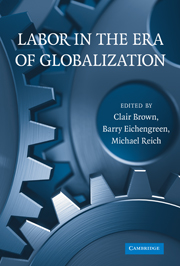Book contents
- Frontmatter
- Contents
- Tables and Figures
- List of Authors and Editors
- Introduction: Labor in the Era of Globalization
- PART ONE POLITICAL ECONOMY AND LABOR MARKET INSTITUTIONS
- PART TWO INSTITUTIONS AND FIRM AND WORKER BEHAVIOR
- 4 How Good Are U.S. Jobs? Characteristics of Job Ladders across Firms in Five Industries
- 5 Increasing Labor Flexibility during the Recession in Japan: The Role of Female Workers in Manufacturing
- 6 Ties That Matter: Cultural Norms and Family Formation in Western Europe
- PART THREE CONTEMPORARY LABOR–MANAGEMENT RELATIONS
- PART FOUR PUBLIC POLICY AND U.S. LABOR-MARKET STRUCTURE
- Index
- References
5 - Increasing Labor Flexibility during the Recession in Japan: The Role of Female Workers in Manufacturing
Published online by Cambridge University Press: 05 June 2012
- Frontmatter
- Contents
- Tables and Figures
- List of Authors and Editors
- Introduction: Labor in the Era of Globalization
- PART ONE POLITICAL ECONOMY AND LABOR MARKET INSTITUTIONS
- PART TWO INSTITUTIONS AND FIRM AND WORKER BEHAVIOR
- 4 How Good Are U.S. Jobs? Characteristics of Job Ladders across Firms in Five Industries
- 5 Increasing Labor Flexibility during the Recession in Japan: The Role of Female Workers in Manufacturing
- 6 Ties That Matter: Cultural Norms and Family Formation in Western Europe
- PART THREE CONTEMPORARY LABOR–MANAGEMENT RELATIONS
- PART FOUR PUBLIC POLICY AND U.S. LABOR-MARKET STRUCTURE
- Index
- References
Summary
INTRODUCTION
In the 1990s, Japan experienced its first prolonged recession since the end of World War II and has emerged from it only in the last few years. During this recession, dubbed “the lost decade,” the very nature of the Japanese company was challenged. What had been considered a virtue that supported full employment in the 1980s has been criticized as a major cause of declining competitiveness for Japanese multinational companies, as well as a cause of the long recession. Among the former virtues, the so-called lifetime employment system has been a primary target for criticism. In the fast-changing global-business environment, giving a lifetime guarantee of a job to employees is considered the last thing an employer wants to do. Following this logic, the reemerged Japanese global firms are expected to have management systems that provide organizational and workforce flexibility.
However, an interesting new view, based on findings that contradict this intuition, seems to be emerging. In this view, Japanese firms have preserved many of the old virtues, including employment stability for regular employees, while also improving workforce flexibility by expanding their use of nonregular employees, who work under different employment rules. This approach creates a bifurcation of employment within a given workplace into favored or primary positions for regular employees and secondary positions for nonregular employees.
In this chapter, we examine the evidence for this new view in four important sectors and present our interpretation. Then, we present national data that support our interpretation.
- Type
- Chapter
- Information
- Labor in the Era of Globalization , pp. 191 - 210Publisher: Cambridge University PressPrint publication year: 2009



